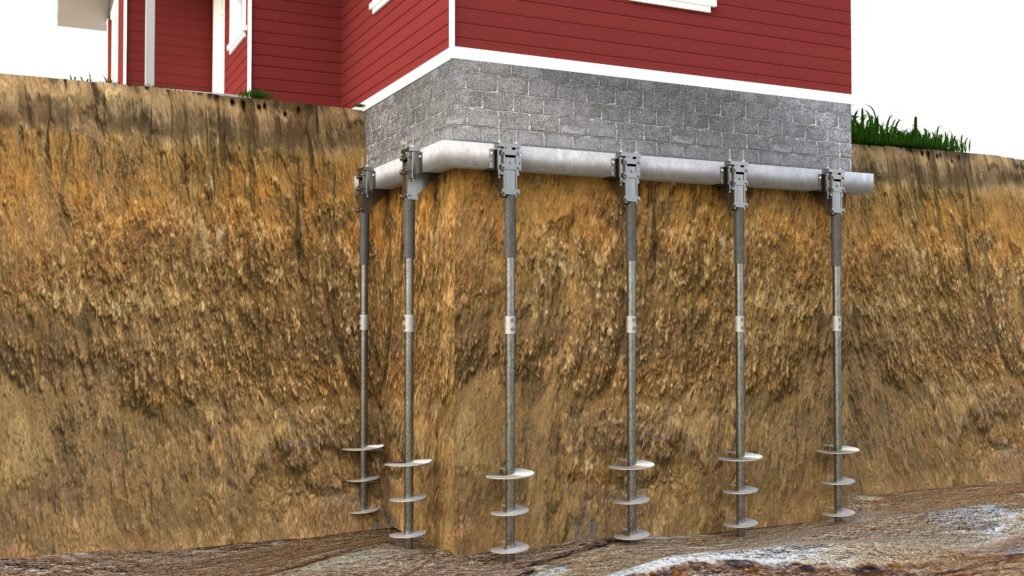Underpinning is the process of bolstering a building or other structure’s foundation during construction or repair. Underpinning may be required for a number of reasons, including:
- The underlying structure isn’t sturdy or solid enough.
- The way the structure is used has changed.
- It’s possible that the characteristics of the soil supporting the foundation altered (perhaps due to subsidence) or were incorrectly described during design.
- The excavation of soil supporting existing foundations is necessary for the development of surrounding structures.
- To extend the depth or load capacity of current foundations to accommodate the building’s construction of a second story (above or below grade).
- Working on the existing structure’s foundation is more cost-effective than constructing a new one, whether this is due to land cost or another factor.
- The structure has moved as a result of an earthquake, flood, drought, or other natural event, necessitating stabilization of the footings and/or foundation soils.
Note: If you house underpinning solutions, visit Mainmark Ground Engineering.
By increasing the foundation’s depth or width, underpinning may be done to either place it on a more supporting soil layer or spread the load over a larger area. Underpinning techniques frequently used include jet grouting and the use of micro piles. A grout that contains expanding designed structural resins based on urethane is an alternative to underpinning for reinforcing soil.
If P class (problem) soils are present in specific portions of the site, underpinning may be required.
The term “underpinning” has changed its meaning to include all abstract ideas that work as a foundation.
Massive concrete piers:
The mass concrete underpinning technique, known as “tradition underpinning,” has been used for close to a century, and the procedure has not altered. By manually excavating boxes beneath an existing structure, pouring concrete in a planned sequence, and adding reinforcements as necessary, this underpinning technique enhances the foundation of the building. As a result, a foundation is constructed beneath the current foundation. The current foundation is often underpinned using this technique, which is effective up to a depth of fifty feet (15 meters). Due to the tiny size of the boxes being dug, hand equipment like shovels and post whole diggers are needed; heavy gear is not used in this procedure. The engineering simplicity, decreased labor costs, and continued usage of the building during construction are only a few benefits of employing this underlying technique.
Beam and base support:
An improved version of the conventional mass concrete underpinning technique is the beam and base approach. A reinforced concrete beam is built underneath, on top of, or in place of the current footing. After this, the beam distributes the building’s weight to mass concrete bases that are built in strategically planned positions. The existing ground conditions affect base sizes and depths. The building’s configuration and the applied loads affect the design of the beams. Precautions against anti-heave are frequently integrated into plans where clay soil expansion may be a possibility.
A mini-piled foundation:
Mini-piles are most frequently used in situations with changeable ground conditions, limited access, high levels of environmental contamination, and low structural movement requirements. When the loads from the foundations need to be transported to stable soils at significant depths, often greater than 5 m, mini-piled underpinning is typically employed (16 ft.). Mini-piles are typically between 150 mm (5.9 in) and 300 mm (12 in) in diameter and can be driven or augured. Structural engineers will employ rigs that can go through a standard household entryway and are specially made to work in spaces with little headroom and space.
Mini-piles are characterized by their relatively tiny diameter and typically employ anchoring or tie backs into an existing structure or rock. The underpinning technique employed here is conventional drilling and grouting. These mini-piles can withstand axial loads in both meanings and have a high slenderness ratio. They also include large steel reinforcing components. [3] Mini-piles can support working loads of up to 1,000 KN (100 long tons-force and 110 short tons-force).
Mini-piles have a little more complex technical component than Mass Concrete Underpinning, incorporating basic engineering mechanics like statics and material strength. Depending on the orientation and application of the design, these mini-piles must be built to operate in both tension and compression. Analysis of settling, bursting, buckling, cracking, and interface consideration must be given careful consideration during design, while practical considerations like as corrosion resistance and compatibility with the existing ground and structure must also be taken into account.
Mini-piled pier laying plans:
Pile and beam, cantilever pile-caps, and piled raft systems are examples of mini-piled underpinning techniques. To each cap of a cantilevered pile-cap, tension and compression piles must be built in order to prevent disturbing the inside of the structure. A beam often connects them. In order to support a wall using the pile and beam method, pairs of piles are typically built on either side of the wall and connected by a pile cap. Typically, reinforced concrete beams connect the pile tops so that they can hold the whole length of the wall. When a whole building needs to be anchored, piled raft underpinning techniques are frequently employed. The interior flooring are entirely removed, a grid of piles is set up, and a reinforced concrete raft is then built over the whole floor level, picking up and providing total support for all internal and external walls.
Underpinning substitute: expanding resin injection:
The earth beneath the footings is injected with a mixture of structural resins and hardener. As something enters the ground, resin and hardener combine, and expansion happens as a result of a chemical reaction. If the injection is sustained, the expanding structural resin mix will compact any weakened soil, fill any holes and fissures, and elevate and level the structure above. This underlying technique, which is still relatively new and has only been around for around 30 years, is regarded as a clean, quick, and non-disruptive underpinning approach because it doesn’t require any construction or excavation set-up.

